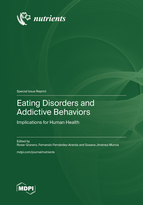Eating Disorders and Addictive Behaviors: Implications for Human Health
A special issue of Nutrients (ISSN 2072-6643). This special issue belongs to the section "Clinical Nutrition".
Deadline for manuscript submissions: closed (15 April 2023) | Viewed by 33500
Special Issue Editors
Interests: eating disorders; behavioral addictions; methodology; clinical psychology; health sciences
Special Issues, Collections and Topics in MDPI journals
Interests: eating disorders; obesity; psychotherapy; translational research; new technologies; comorbidities
Special Issues, Collections and Topics in MDPI journals
Interests: behavioral addictions; gambling disorder; gaming disorder; buying-shopping disorder; sex addiction; food addiction; interventions based on new technologies
Special Issues, Collections and Topics in MDPI journals
Special Issue Information
Dear Colleagues,
Eating disorders (ED) are mental disorders with significant impact on physical–medical health (e.g., gastrointestinal, renal, or cardiovascular) and psychological wellbeing (adequate relationships with others, personal growth, or autonomy). The most frequent eating disorders include anorexia nervosa, bulimia nervosa, and binge eating disorder. These three clinical conditions share an excessive focus on weight and body image, leading to dangerous eating styles that affect the body's ability to obtain adequate nutrition and cause clinical impairment in different areas of functioning.
The etiology of ED comprises a complex network of biological, psychological, and contextual–social factors. The onset of eating-related problems is usually during school-age and adolescence; however, the progression of the disorders evolves across the lifespan. Diverse phenotypes have been identified according to eating disorder subtypes, and it has been observed that the physio-pathological mechanisms underlying each behavioral profile can play a role in the treatment outcomes.
This Special Issue, “Eating Disorders and Addictive Behaviors: Implications for Human Health”, aims to identify the underlying triggers of this complex dual comorbid condition, to establish orthogonal diagnostic criteria, and to differentiate the patterns of eating and addiction features (central symptoms). Manuscript submissions may include original research articles (clinical, translational, or basic research), systematic reviews, and meta-analysis. The new evidence of these studies can provide, from a multidisciplinary perspective, the basis for developing evidence-based intervention plans to meet the needs of patients with comorbid ED with BA.
Dr. Roser Granero
Prof. Dr. Fernando Fernández-Aranda
Dr. Susana Jiménez-Murcia
Guest Editors
Manuscript Submission Information
Manuscripts should be submitted online at www.mdpi.com by registering and logging in to this website. Once you are registered, click here to go to the submission form. Manuscripts can be submitted until the deadline. All submissions that pass pre-check are peer-reviewed. Accepted papers will be published continuously in the journal (as soon as accepted) and will be listed together on the special issue website. Research articles, review articles as well as short communications are invited. For planned papers, a title and short abstract (about 100 words) can be sent to the Editorial Office for announcement on this website.
Submitted manuscripts should not have been published previously, nor be under consideration for publication elsewhere (except conference proceedings papers). All manuscripts are thoroughly refereed through a single-blind peer-review process. A guide for authors and other relevant information for submission of manuscripts is available on the Instructions for Authors page. Nutrients is an international peer-reviewed open access semimonthly journal published by MDPI.
Please visit the Instructions for Authors page before submitting a manuscript. The Article Processing Charge (APC) for publication in this open access journal is 2900 CHF (Swiss Francs). Submitted papers should be well formatted and use good English. Authors may use MDPI's English editing service prior to publication or during author revisions.
Keywords
- eating disorders
- eating behavior
- anorexia nervosa
- bulimia nervosa
- binge eating disorder
- addictive disorders
- addictive behavior
- nutrition
- evidence-based treatment
- interventions
- treatment
- outcomes









